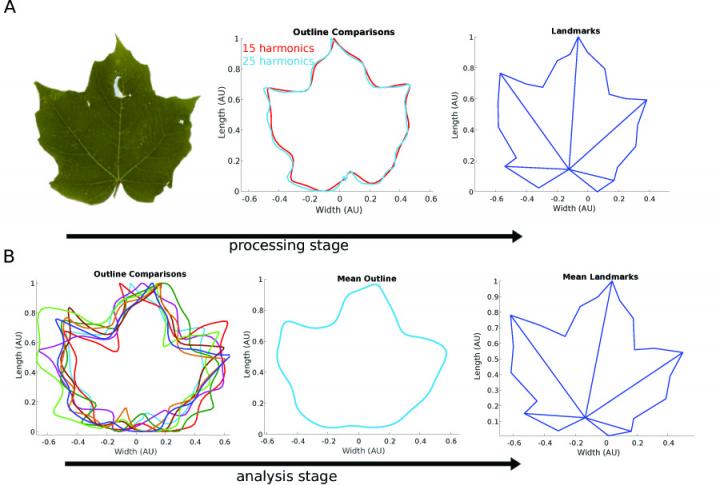
Credit: Chuanromanee, T. S., J. I. Cohen, and G. L. Ryan. 2019. Morphological Analysis of Size and Shape (MASS): An integrative software program for morphometric analyses of leaves. Applications in Plant…
Analysis of leaf shape and size is a cornerstone of botany, and is crucial in answering a variety of ecological, evolutionary, genetic, and agricultural questions. However, the software packages used to conduct these morphometric analyses can be cumbersome, and sometimes require stringing multiple programs together. This slows the rate of progress in the field, creates higher barriers of entry for newcomers, and introduces unnecessary errors to these calculations. In research presented in a recent issue of Applications in Plant Sciences, Dr. Gillian Ryan and colleagues introduced a new software program, MASS (Morphological Analysis of Size and Shape), that they developed to streamline the process of running geometric morphometric analyses on leaf shape.
“We wanted to automate as much of the morphometric analyses as possible,” explains Dr. Ryan, Associate Professor of Physics at Kettering University and corresponding author of the paper. “Both to minimize the number of manual measurements, which can be tedious, and to improve the reproducibility of geometric measurements.” To that end, MASS includes functions to scale and measure the features of a leaf based on an image, as well as a suite of functions for interrogating that data, including Fourier, Procrustes, and principal component analyses.
The inclusion of multiple functions into one program will be welcome for researchers who are currently manually editing files to fit formatting requirements between these programs, which introduces more opportunity for human error. “I think this is a common issue in many STEM fields where individual groups and teams are developing analysis tools and pipelines for their own work, sometimes in parallel,” says Dr. Ryan. “As new users adopt these analysis methods it can be challenging to combine multiple tools that were not necessarily designed to be used together.”
Reducing the complexity of running these morphometric analyses has benefits to the field beyond just reducing errors. “One of the primary goals of the MASS project is to streamline these analyses and to make them more accessible to a broader pool of potential users — including novice researchers and trainees,” says Dr. Ryan. “This has the added benefit of making it easier to collect and analyze larger groups of data, which we hope will aid in comprehensive future studies.”
The timing is right to scale up morphological studies, too, as large datasets of digitized herbarium specimens come online. “It was important that we were able to demonstrate that MASS could use these [digitized herbarium] specimens so researchers could take advantage of all of those already online. It really opens up the ability to use these digitized specimens to answer interesting research questions,” says Dr. Ryan. “With so many large-scale digitization projects having occurred (and currently taking place), the number of specimens available online is incredible.”
###
Tya S. Chuanromanee, James I. Cohen, and Gillian L. Ryan. 2019. Morphological Analysis of Size and Shape (MASS): An integrative software program for morphometric analyses of leaves. Applications in Plant Sciences 7(9): e11288. https:/
Applications in Plant Sciences (APPS) is a monthly, peer-reviewed, open access journal focusing on new tools, technologies, and protocols in all areas of the plant sciences. It is published by the Botanical Society of America, a nonprofit membership society with a mission to promote botany, the field of basic science dealing with the study and inquiry into the form, function, development, diversity, reproduction, evolution, and uses of plants and their interactions within the biosphere. APPS is available as part of the Wiley Online Library.
For further information, please contact the APPS staff at [email protected].
Media Contact
Beth Parada
[email protected]
Related Journal Article
http://dx.




